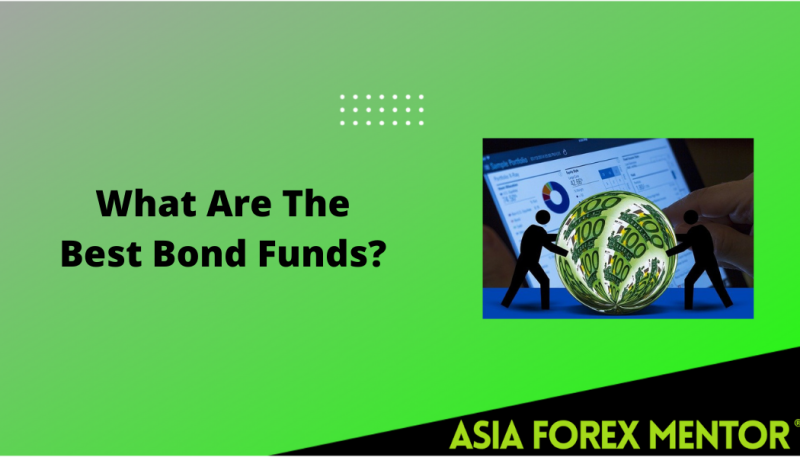
Most people identify investing with the stock market. Yet for a comprehensive portfolio, traders must create a solid combination of stocks that get balanced out with bonds. Investors are not especially enthusiastic about bonds because they are an instrument that provides a fixed income. There is no large price rise, which is characteristic of stocks.

However, the plus side is in minimal volatility, and by incorporating bonds in the portfolio, investors can reduce losses if the stock market takes a turn for the worst.
Also Read: Everything About Credit Spread
Contents
- Are All Bonds the Same?
- Interest Rate Risk
- How We Select the Best Bond Funds
- Total Bond Market Index Funds
- Is Investing in a Total Bond Market Index Fund Recommended?
- Best Bond Index Funds
- Best Actively Managed Bond Funds
- Best Municipal Bond Funds
- Conclusion
- FAQs
Are All Bonds the Same?
For the majority of investors, especially the ones that don't have the experience, bonds can be a confusing asset to trader and own. It's easy to say that a fixed income can be a wise choice, but how do you go about managing that strategy?
Learning all the details about the bond market dynamic can be challenging. Understanding the puzzle that is the bonds can be easily done by investing in the total market bond index fund.
When traders purchase shares in a U.S. total bond market fund, they get access to the whole bond market. It takes only a single fund to invest in agency and corporate bonds, U.S. treasury bonds, and a diversity of fixed-income investments.
Incorporating bonds is an important element in retirement investing plan. But also as an investment portfolio from a taxable aspect. The total bond market fund can reduce the volatility in a portfolio, and it doesn't make a difference if investors are creating two or three-fund portfolios. Maybe even select a more complex format.
There are numerous options of funds that are investment-grade, for example, Vanguard is a very attractive option for individual investors. These funds are exchange-traded (ETFs), index, and mutual funds, and because of the reduced expense, they permit investors to keep a large quantity of the profits that get created by the investment.
Interest Rate Risk
Although bonds offer many benefits, investors worry about the interest rates. When it is low the yield will be proportionally smaller, and that affects retirees. Dissipate that investors believe it's a piece of sound advice to retain bond funds in the portfolio for retirement.
Bonds provide diversification in the portfolio an investor needs. It helps control the volatility and provides a large dividend this is the case even if the payout is not great from the bonds. Investors have been trained to pay attention to the yield. And not the total return, and the latter is the price appreciation in combination with the yield.
We took a deep dive into the market and analyzed all of the best total bond index funds that are in the USA and offer solid opportunities for investors.
How We Select the Best Bond Funds
There are multiple reasons why someone would decide to purchase and hold bond funds. For some the aim is to create stability, others see it as a source of income, while professionals consider it a crucial part of their diversification strategy.
The goal of long-term investors most frequently is diversification. But retired investors could be attempting to meet all of the previously mentioned goals.
The fact remains that the best bond funds provide a mixture of low costs and wider diversification for all investors.
The list of the bond market is pretty extensive and includes bond index funds, high-income (junk) bond funds, short-term bond funds, corporate bond funds, U.S. Treasury bond funds, emerging market bond funds, foreign bond funds, treasury inflation-protected (TIPS) bond funds, municipal bond funds, intermediate-term bond funds, long-term bond funds, and multi-sector bond funds.
Divers Methodology
The methodology implemented in examining every market got based on over a dozen index funds. But our team did not include funds that didn’t cover the whole market. Such as specialist bond funds that invest primarily in Treasury Inflation-Protected Securities (TIPS), municipal bonds, or high-yield corporate bonds, but also diligently managed bond funds.
In examining the broad market bond index funds, a few crucial elements were taken into account. Every fond was inspected based on their five-year returns, the tracked index, and expense ratio.
The fund’s five-year return is especially important, and the reason is in the credit risk. When compiling the list we considered low-cost, the ever-important diversified, no-load bond funds.
Apart from the five-year returns, we focused on the TTM, which is the trailing yield for the last 12-months. This aspect offers a better insight for investors in the present bond market. The five-year or the ten-year return sometimes can obscure data that the TTM can reveal for potential investors.
Total Bond Market Index Funds
For the untrained eye, it's very difficult to differentiate between the total bond market index funds. Although most of the funds included in our list get tracked by the Bloomberg Barclays US Aggregate Bond Index, the main reason for this is the perception as the key benchmark index for the U.S. bond market, which encompasses every significant form of fixed income.
But if you make a more detailed examination, crucial differences start to appear. The most obvious one is the expense. Selecting an index fund that offers fees that are on the low side makes it possible to increase the profits over the investment lifetime. Most of the suggested funds move at price from two and a half basis points to forty-five basis points.
But there are also total bond market funds that follow different indexes, such as the U.S. Universal Index. Whit this index you can locate better-yielding investment opportunities from emerging bond markets that provide better returns on the initial investment but at the expense of more risk and higher cost.
Is Investing in a Total Bond Market Index Fund Recommended?
The advantage of investing in index funds is in the reduced fees than what is the norm with purchasing diligently managed mutual funds. Logically, the reduced initial expense will offer higher returns following the fee payments in the long term. This aligns for equities and fixed-income investments.
By following the performance of diligently managed funds concerning the corresponding benchmark over several asset classes, investors can see that actively managed funds will underperform the respective index in the five-year periods.
Investors should not focus only on performance, they need to track two other crucial elements. At least one of them is the period of the fund.
This aspect makes it possible to discover the degree to which a fund will gain or lose in value with the shifting interest rates that can go up and down. Typically for every one percent in the shift in an interest rate, and it could be in both directions, the value of the fund will appropriately increase or decrees by a percentage for its duration.
Let's take an example of a fund that has a duration of about six years. In this case, a rise in the rate of one percent will result in a six percent decline in the value of the fund. The opposite is true in a case of a decline of one percent in the current rates, this will influence the value of the fund by raising it by six percent.
In the past, the interest rate was typically low, but this doesn't stay fixed and that means there is a present risk in a total bond index fund.
The second factor is that only fixed-rate securities are present in the Bloomberg Barclays bond index. The effect of this is that the index and the funds that are being tracked are not invested in TIPS, and this safeguards investors from sudden spikes in interest rates in inflation.
Best Bond Index Funds
One of the best options for investors that are searching for a diversified selection of bonds is the bond index funds. We will have a closer inspection of some options.
Vanguard Total Bond Index (VBTLX)
There are thousands of bonds held within this bond fund, which reflects the entire range of the U.S. bond market that gets publicly traded. It is the bond funds investors gravitate to when they plan to expand. The VBTLX offers stability by controlling risk and low-cost.
The expense ratio of the fund is relatively low at 0.05%. And the analogous ETF trades as BND one-share minimum purchase and an expense ratio of 0.035%.
Fidelity Total Bond (FTBFX)
Investors that are on the lookout for a widely diversified index fund, can't go wrong with the FTBFX. In the long run, it can offer larger returns when compared with similar funds.
The FTBFX is more concentrated than VBTLX, for example, the former held about three thousand in 2021, while the latter at the same period had little ten thousand bonds.
What this means for investors is that in the long run, we are talking about a period of a decade and more, the returns can be much higher. Although the risk is larger if corralled against regular core bond index funds.
The expense ratio for FTBFX is 0.45%, without a minimum initial investment.
Vanguard Intermediate-Term Bond Index (VBILX)
For intermediate-term bonds than the VBILX can be an adequate choice. These types of bonds provide higher yields and get perceived as a very opportune investment option. One reason is the fact that long-term performance is better than short-term bonds. They also offer reduced market risk. Investors benefit from the adequate combination of risk management and
The fund invests primarily in high-grade corporate bonds. The net effect of this is stability and a moderate income.
Best Actively Managed Bond Funds
If the market risk is not a discouraging factor, then investors that plan to commit for the long term can consider getting into an actively managed bond fund. These types of funds can hold various bonds in different markets.
Multi-sector is one classification of actively managed bond funds. These funds can hold riskier high-yield bonds that are riskier, but also foreign bonds, and different types of bonds. We can have a look at two multi-sector bond funds.
Fidelity Strategic Income Fund (FADMX)
Higher risk is one prerequisite for higher rewards and investors that are prepared for that bargain can turn to FADMX. This is a solid fund for people that have a tolerance that is in the level between moderate-to-high risks, and want to get a more substantial income from the investment.
FADMX is a great option if you are prepared to swap returns under the average in the short term for a yield of 2.14%.
Investors have to be persistent when searching for returns that are over the average. In long-term periods FADMX frequently generates better returns, although this is not the case for shorter periods.
The FADMX expense ratio is quite low at 0.67%, which is unusual for a multi-sector bond fund a. Plus, there is no minimum initial investment.
Loomis Sayles Bond (LSBRX)
The advantage of LSBRX is that in the long run investors can see returns that are similar to the ones for stocks. But there is a downside, and that is that as is the case with stock here there is a risk for declines in certain tough markets.
There can be substantial fluctuations, following the economic crisis in 2008 the LSBRX declined by 22% but is bounced back a year later to 37%.
Most investors are aware that profits don't come without some form of risk, and a frequently higher level of risk will potentially produce a performance that is over the average in the long run.
The LSBRX has an expense ratio of 0.92%, which is relatively moral if one considers the experienced team that manages the fund.
Best Municipal Bond Funds
If your goal as an investor is to reduce the federal tax burden that comes with some forms of bonds then investment-grade municipal bonds can provide that option. These types of bonds are excluded from federal taxes. But also may not get subjected to state taxes. This is especially relevant if the fund holds bonds that were issued by the state in which you have a primary residence.
The funds do not implement a region-specific approach but hold bonds from all over the USA, which is why the odds for increasing long-term returns are improved. Investing in this type of fund can generate potential higher yields.
USAA Tax-Exempt Intermediate-Term (USATX)
If on the market for a well-managed municipal bond fund, then USATX can be a nice addition to the portfolio. The reason this fund is on the list is the exceptional performance it displays over various funds that are also in the tax-exempt category.
The expense ratio of 0.49% which is under the norm at just is another positive aspect.
Vanguard High Yield Tax Exempt (VWAHX)
If searching for a low-cost municipal bond fund that provides a solid balance of return and yield then the VWAHX is a good choice. The five- and ten-year returns frequently outperform a high-yield bond index.
By investing in the fund, you get access to quality no-load municipal bond funds in the mutual fund world, that offer a good mix of yield and performance, and expenses of 0.17%.
Conclusion
Bonds are fixed-income securities that provide a lower degree of risk when compared with the stock market. The big benefit of bonds is they can increase their value even when stocks are declining. Investors prefer to use mutual funds as an option for a diversified portfolio by mixing stocks with bonds. Investment-grade bonds are a crucial segment of most portfolios because they soften the effects of bear markets.
There are different types of bonds, most investors focus on government bonds and corporate bonds. Some look at emerging markets, but whatever investment strategy you are preparing, the crucial factor is the research will reduce risk.
Focus on dividend yields and past performance of a fund, compared with other funds, but also its market value. That way investors can discover if the investment objectives can be met.
This list of bond funds offers solid opportunities, but the final choice will depend on personal finance the trust in the bond issuer, and the overall fund's portfolio. These funds may not be suitable for your investment goal and risk tolerance.
FAQs
Which Bond Fund Is Best?
There is no one best fund, choices are subjective and depend on personal investment goals. When selecting a bond fund, investors focus on their objectives and see which option can help them accomplish those aims.
Are Bond Funds a Good Investment?
Bond funds offer a diversified portfolio with fixed-income securities that offer relatively small risk in return for a steady income with lower relative risk than stocks in general.
What Is the Safest Bond Fund?
Bond funds that get perceived as safe options include government bond funds, short-term investment-grade corporate bonds funds, and municipal bond funds.
Is Bond Fund a Good Investment?
It depends on what the investor is looking for bonds offer reduced risk, which doesn't mean investors can't lose money but compared with stock they can offer fixed income.

















